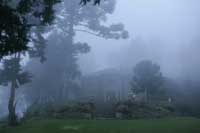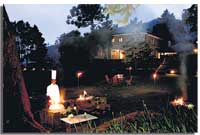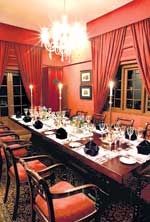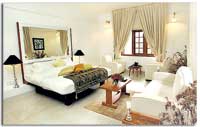Hot spot in cool climes
By Royston Ellis
 |
| The White Suite (left) and (above) Warwick, shrouded in mist. Pix by Gemunu Amerasinghe |
One of the oldest plantation bungalows has become the newest ‘hot’ place to stay, in the manner of a trendy boutique hotel. But Warwick Gardens at Ambewela is much more than a fashionable retreat for conspicuous spenders; it is a creation of colonial chic done with contemporary flair.
If that sounds like pretentious brochure prose it is meant to polish the image of staying in a plantation bungalow and give it a modern shine. In the past when tea planters took paying guests to boost their income, bungalows were sparsely furnished, chilly at night, the beds damp, and the bathrooms treacherous.
With Warwick Gardens, the bungalow holiday has entered a new dimension. The word ‘bungalow’ is a misnomer for this two-storey, granite-block mansion set on a hillside where hovering dawn mists evaporate to reveal valleys bathed in sunlight. At times the only sound is the warble of birds as they flit across flower beds of blue agapanthus blooms.
It is an impressive building to arrive at after a winding drive from the turn off at Boragas on the road linking Nuwara Eliya and Welimada. That the original house was built 118 years ago defies belief: how was it done without motor transport and cement mixers? Just as incredible is the restoration wrought by its new owners, Hiran and Dharshi Cooray, aided by architect Channa Daswatte. After the last British planter moved out in the 1950s, followed by nationalisation of all but 30 acres of the 1,280-acre Warwick plantation, the house was little used.
To stay at Warwick Gardens today is to experience something more fulfilling than when British planters were in rarefied residence. Guests are invited to make themselves at home, and can wander the house at will, even popping into the kitchen to chat with the resident cooks.
 |
| It’s barbeque night at Warwick |
Entrance to the house is down a flight of granite steps, skirting around an 80 year-old tree that was considered too noble to move, to a veranda of flagstones fronting the lawns and valley view. Tall French windows give access to the reception hall, at one end of which is the television lounge. At the other end is the library where volumes relating to the history of tea and of the area are available for guests to browse through. This also serves as the office and is where payment is made at the end of the stay.
 On my arrival the manager, Dr. Faris, explained that guests don’t sign for anything; they order what they want, when they want, and the butler quietly makes a note of it. On my arrival the manager, Dr. Faris, explained that guests don’t sign for anything; they order what they want, when they want, and the butler quietly makes a note of it.
Dr. Faris is an agriculturist who acts as the host and leads guests on exploratory trails of the tea gardens and woodlands and regales visitors with the history of the house. He himself planted tea on the estate in the 1990s.
There is one bedroom on the ground floor with three bedrooms, including the master suite, up the flight of teak stairs, past a tapestry of Rajasthan carpets hanging from ceiling to floor. The master suite has a fireplace and a traditional, but divinely comfortable, four poster bed with lavish duvet. The bathroom is flagrantly retro with black and white tiles, a cast iron bath tub in its centre, an old kitchen table supporting wash basins, and a glass walled corner with, thankfully, a hot water shower.
So what’s behind the wall hanging on the landing? That’s the house’s secret, an additional bedroom, called Netherleigh or the White Suite, created out of space by Channa Daswatte. Its uncluttered lines with slab bed and white titanium cement floors contrast delightfully with the opulence of the bungalow’s public rooms.
 The drawing room downstairs has been lovingly furnished with antiques and reproductions, its walls hung with prints and brightened with original paintings. There are two settees plump with cushions, a baby grand piano and a fireplace. Beyond a huge arch with a background of a burgundy-coloured wall, is the formal dining room with a table seating 12. Beyond that is the breakfast room where guests who do not wish to dine with others, can eat privately. Breakfast and lunch can also be served on the side patio or on the lawn, and there is a garden barbecue corner. The drawing room downstairs has been lovingly furnished with antiques and reproductions, its walls hung with prints and brightened with original paintings. There are two settees plump with cushions, a baby grand piano and a fireplace. Beyond a huge arch with a background of a burgundy-coloured wall, is the formal dining room with a table seating 12. Beyond that is the breakfast room where guests who do not wish to dine with others, can eat privately. Breakfast and lunch can also be served on the side patio or on the lawn, and there is a garden barbecue corner.
The five bedrooms are available individually at a rate that includes breakfast and dinner. Much of the produce comes from the estate and the aim is to use only organic ingredients. Neither plastic nor polythene are ever seen and there are no telephones or televisions in the bedrooms.
Although Warwick Gardens recaptures the ambience of the 1950s, I was amazed to see that a three-wheeler had made the journey from the village bringing provisions. It was comforting to realise that, in fact, the conveniences of the 21st century are not far away. (www.jetwinghotels.com) |



 On my arrival the manager, Dr. Faris, explained that guests don’t sign for anything; they order what they want, when they want, and the butler quietly makes a note of it.
On my arrival the manager, Dr. Faris, explained that guests don’t sign for anything; they order what they want, when they want, and the butler quietly makes a note of it. The drawing room downstairs has been lovingly furnished with antiques and reproductions, its walls hung with prints and brightened with original paintings. There are two settees plump with cushions, a baby grand piano and a fireplace. Beyond a huge arch with a background of a burgundy-coloured wall, is the formal dining room with a table seating 12. Beyond that is the breakfast room where guests who do not wish to dine with others, can eat privately. Breakfast and lunch can also be served on the side patio or on the lawn, and there is a garden barbecue corner.
The drawing room downstairs has been lovingly furnished with antiques and reproductions, its walls hung with prints and brightened with original paintings. There are two settees plump with cushions, a baby grand piano and a fireplace. Beyond a huge arch with a background of a burgundy-coloured wall, is the formal dining room with a table seating 12. Beyond that is the breakfast room where guests who do not wish to dine with others, can eat privately. Breakfast and lunch can also be served on the side patio or on the lawn, and there is a garden barbecue corner.